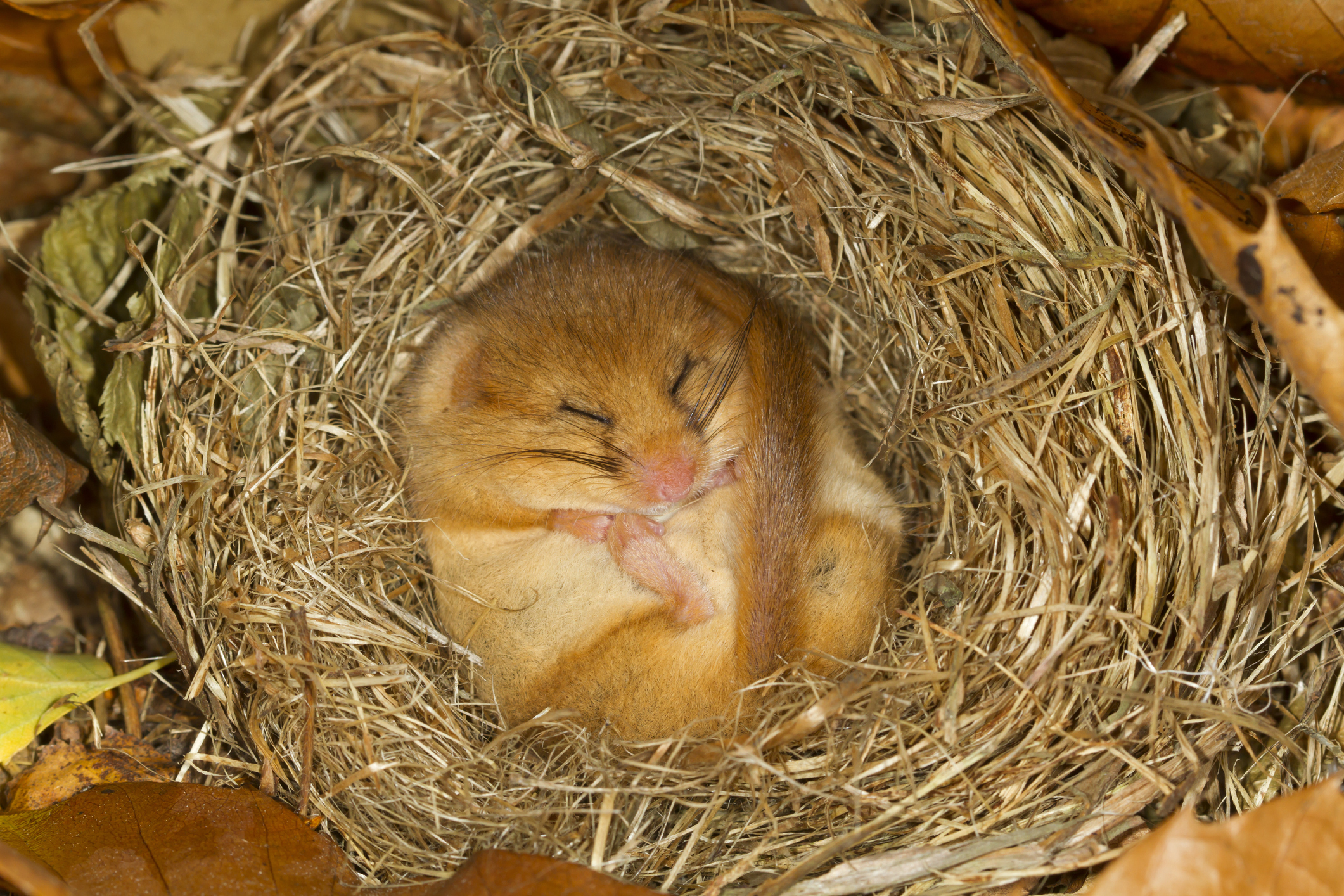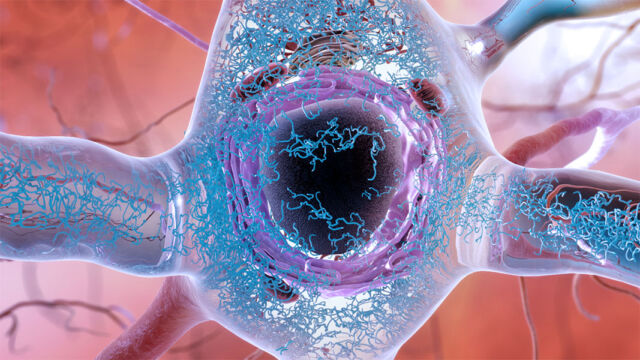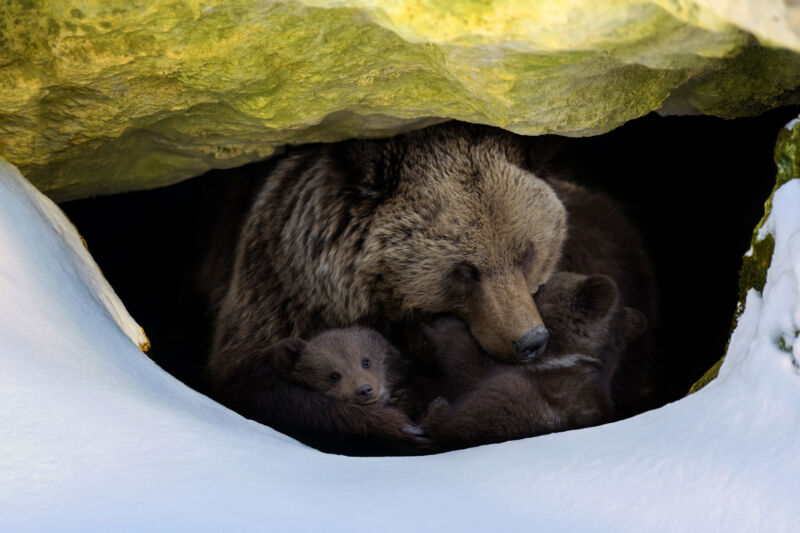Every spring, as days in the north stretch longer and melting snow trickles into streams, drowsy animals ranging from grizzlies to ground squirrels start to rally from hibernation. It’s tempting to say that that they are “waking up,” but hibernation is more complicated and mysterious than a simple long sleep: Any animal that can spend months underground without eating or drinking and still emerge ready to face the world has clearly mastered an amazing trick of biology.
The roster of animals that hibernate includes all manner of rodents, some amphibians and even a few primates (several species of dwarf lemurs), but bears are literally the biggest hibernators of them all. Adult grizzly and black bears weigh as much as American football players, or more, with the energy and curiosity of preschoolers, but they have no trouble hunkering down for months at time. The choreography that goes into shutting down a creature this big defies easy explanation, says Elena Gracheva, a neurophysiologist at Yale University in New Haven, Connecticut. “Hibernation is so complex it requires adaptations at multiple levels,” she says.
Bear hibernation offers important insights into the workings of large mammals, especially us, explains Gracheva, who coauthored an exploration of the physiology of hibernation in the 2020 Annual Review of Cell and Developmental Biology. A better understanding of the process could potentially change our approach to a wide range of human conditions, including stroke, osteoporosis, Parkinson’s disease and Alzheimer’s (see sidebar).
Bears, too, will have to rethink their concept of hibernation as the climate warms and winters grow shorter. How they respond will say much about their commitment to winter naps, and about the deep interconnections between climate and animal behavior.
Not cool
Bears take an approach to hibernation that’s far different from other slumberers. Arctic ground squirrels can temporarily drop their body temperature to -3°C (27°F) without freezing solid. Bears, in contrast, hardly lose any heat at all in their winter dens, but they still qualify as hibernators because their metabolism slows to a crawl. It’s a process that Brian Barnes, a zoologist at the University of Alaska Fairbanks, and his colleagues carefully tracked more than a decade ago by studying black bears hibernating in artificial dens.
The winter quarters were actually chambers that could gauge oxygen intake and carbon dioxide production, important measures of metabolism, while sensors tracked body temperature. It was the first study to definitively show that animals could hibernate without cooling down.
Still, hibernating bears aren’t just resting away the winter, Barnes says. They truly shut down, completely resetting the parameters of their daily lives. “They go in, turn around two or three times, lie down, and they stay that way for six months,” he says, and they only get up to switch sides every few days. “Hibernation defines the outer limits of what’s possible in terms of mammalian function.” Barnes notes that sow bears often nurse twins or triplets during hibernation without eating or drinking, tapping into their own fat and water stores for the sake of their cubs.
For humans, that level of lethargy would come at a cost. Whether we were recovering in a hospital bed or riding a rocket to Mars, our muscles would wither and our bones would thin after months of inactivity. Bears have no such problem. Part of the secret to their strong bones is just now coming to light. In 2021, Barnes and colleagues published a study showing that hibernating bears are able to shut down genes involved with the breakdown of bone.
The researchers suggest that it might someday be possible to manipulate the same process in people to prevent osteoporosis. Barnes adds that such an approach could be especially helpful for people confined to extended bed rest, the closest humans currently get to hibernating.
The sluggish metabolism of hibernating bears is an amazing feat in itself. A bear can slow its breathing and heart rate by about 75 percent for months at a time while maintaining a comparatively high body temperature. While nobody knows exactly how they put on the metabolic brakes, Gracheva says the strategy makes good sense. She suspects that bears don’t chill out like ground squirrels because it would take far too much energy to rewarm their large bodies in the spring. Instead, they curl up, letting their fat and fur keep them warm with just a few occasional shivers to help keep blood moving.
The mastery of near suspended animation by human-sized (or bigger) animals has of course caught the attention of science fiction writers and others who dream of someday being able to send astronauts around the solar system as they “hibernate” away the months or years on limited oxygen, food and exercise. More immediately, it might be possible to use the lessons of hibernation to protect people in intensive care.

As Barnes explains, heart attacks and strokes greatly reduce the supply of oxygen and nutrients to the brain. That lack of supply would be much less damaging if doctors could rapidly reduce the demand by putting a patient in a state of hibernation, or something like it. Barnes notes that stroke victims are most likely to benefit from treatment in the first hour after the stroke. Doctors call their window of opportunity to restore blood flow the “golden hour.” If doctors could replicate hibernation to a point where the brain’s needs don’t outstrip supply, “that golden hour could be a golden week or three weeks,” Barnes says.
The speculation may soon be over: In March 2021, researchers in the United States and China, inspired by the hibernators of the animal world, proposed a study that would use a combination of the sedative drug promethazine and the antipsychotic drug chlorpromazine to temporarily create a “hibernation-like state” in stroke patients with the ultimate goal of preserving brain function.
Wake-up call
Bear hibernation stands apart in other ways. Some rodents and other animals hibernate on strict schedules governed by day length. Bears, however, decide for themselves when to shut down and when to recover, explains Heather Johnson, a research wildlife biologist with the US Geological Survey in Anchorage, Alaska. That timing is driven by a number of cues including food supply and, importantly, temperature.
In a study published in 2017, Johnson and colleagues tracked the hibernation of 51 female black bears for an average of three years each in the vicinity of Durango, Colorado. The total length of hibernation varied widely, from less than four months to more than seven months, depending on age and parental status. Older bears and mothers with cubs tended to hunker down longer than younger bears that were on their own. But all of the bears were clearly paying attention to the weather as they prepared to return to active life.
On average, bears left their dens 3.5 days earlier for every rise of 1 degree Celsius (1.8 degrees Fahrenheit) in the average minimum temperature in spring. “When a temperature gets to a certain level, that’s their cue that it’s time to come out of hibernation,” Johnson says.
Likewise, brown bears in Scandinavia seem to wait for temperature to reach a threshold before emerging from their winter dens, says Alina Evans, a wildlife veterinarian at Inland Norway University of Applied Sciences in Evanstad. In a study published in 2016, Evans and colleagues followed the hibernation routines of 14 bears that had been fitted with satellite collars and monitors that tracked heart rate and body temperature.
The bears chose different times and places (tree roots, caves, dug-out ant hills) to start denning, but they all left their dens when the average daytime temperature approached 5°C (about 40°F). Evans thinks that temperature is what coaxes them to come out, but adds that there are other possibilities. Bears may also pay attention to unpleasant wetness from melting snow, for example.
As winters grow milder in a warming climate, bears will undoubtedly start emerging from their dens earlier, Johnson says. It’s hard to say if such shifts have already happened, but, anecdotally, there are many stories of bears that show up in towns or on cabin porches during a winter warm spell. She worries that shorter hibernation periods could give bears more time to get into trouble. Bears that emerge early from dens have more chances to tip over garbage cans, get hit by cars or end up in the crosshairs of a hunter. “Bears have a pretty much 100 percent survival rate while they’re hibernating,” she says. “Otherwise, it’s a dangerous world for them.”
Bears generally time their hibernation so that they’re bedded down when food is scarce but are active during times of plenty, Evans says. She’s concerned that changing temperatures could throw off that schedule. In theory, an early warm spell could drive bears out of the den early, only to be plunged back into cold when they’ve already started losing winter weight. “They may be missing an opportunity to save energy in a harsh environment,” she says.
In some cases, a sudden change in climate could temporarily turn bears into overeaters, Gracheva says. Typically, a bear will lose as much as 30 to 40 percent of its body weight — mostly fat — during hibernation. If a bear wakes up early several years in row, all of those spring meals could add unwanted pounds. “The bear could become obese,” she says. “They could become susceptible to diabetes in the way that we are.”
But in the long term, bears will eventually be able to adjust their eating and hibernation schedules to fit into a warming world, Evans says. After all, she notes, black bears thrive in the swamps of Florida and the woodlands of Mexico, and brown bears have a foothold in southern European countries where harsh winters have mostly gone away with the Ice Age. Some bears in warmer climes have decided to skip hibernation entirely. Bears in Greece and Croatia may not den at all unless they are pregnant, she says.
Hibernation may be less urgent in a warming world, but scientists are more eager than ever to understand the process.
What animal hibernation can teach us about Alzheimer’s and Parkinson’s

In some respects, hibernating bears, ground squirrels and other animals share striking similarities with people suffering from Alzheimer’s or Parkinson’s disease. In humans, those diseases are marked by a buildup of “tau” proteins that form tangles in the brain. Hibernating bear and squirrel brains go through a similar transformation, perhaps because the proteins help to protect neurons during the long rest. “During hibernation, there is a massive accumulation of tau in the brain and central nervous system,” says Elena Gracheva, a neurophysiologist at Yale University.
The big difference: While tau proteins continue to accumulate in Alzheimer’s and Parkinson’s patients as the disease inevitably worsens, hibernators quickly clear the tangles in an impressive feat of spring cleaning. Their brains show no signs of damage, and their memories and motor skills are completely intact. “Hibernators do just fine,” says Gracheva, whose work is partly funded by the Michael J. Fox Foundation for Parkinson’s Research.
Could it ever be possible to give human patients a similar awakening? Gracheva cautions that the science is still at an early stage, but researchers are carefully studying hibernation to gain new insights into progressive brain disease. A 2021 study published in Scientific Reports found that a single round of induced hibernation and awakening strengthened the brain connections and improved the memories of mice that had a condition very similar to Alzheimer’s. The authors suggest that it might be possible to develop drug therapies that could provide a similar cognitive boost to people, no hibernation required.
Gracheva, who has spent much of her career working with hibernating ground squirrels, is now part of a team of researchers studying the brain changes that cause cognitive impairment in people with Parkinson’s disease. Specifically, she will be working on gene sequencing to help better understand the genetic difference between the brain cells that are vulnerable to Parkinson’s disease and the brain cells that remain unaffected.
She’ll be using some of the same approaches that she has used in her studies of hibernators — another nod to remarkable similarities between animals awaking and reactivating in the spring and people who seek a quite different kind of recovery. “Studying bears and marmots,” she says, “can tell us something very fundamental about how the human nervous system functions.”
This story originally appeared in Knowable Magazine.



3175x175(CURRENT).thumb.jpg.b05acc060982b36f5891ba728e6d953c.jpg)

Recommended Comments
There are no comments to display.
Join the conversation
You can post now and register later. If you have an account, sign in now to post with your account.
Note: Your post will require moderator approval before it will be visible.